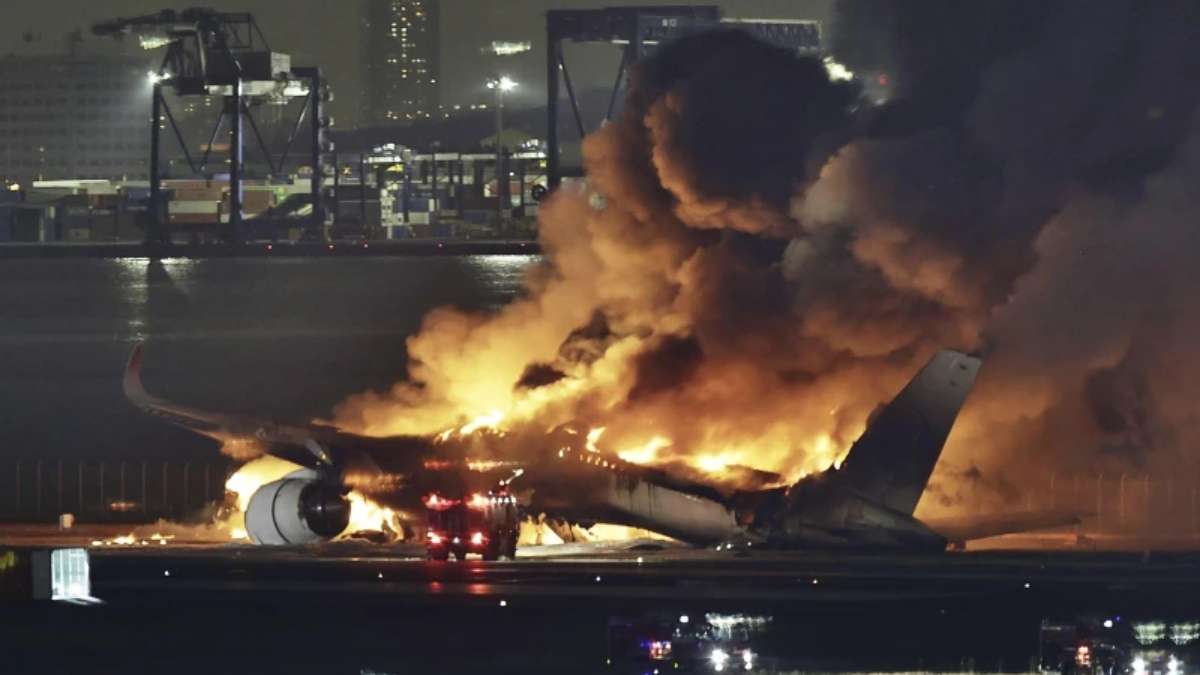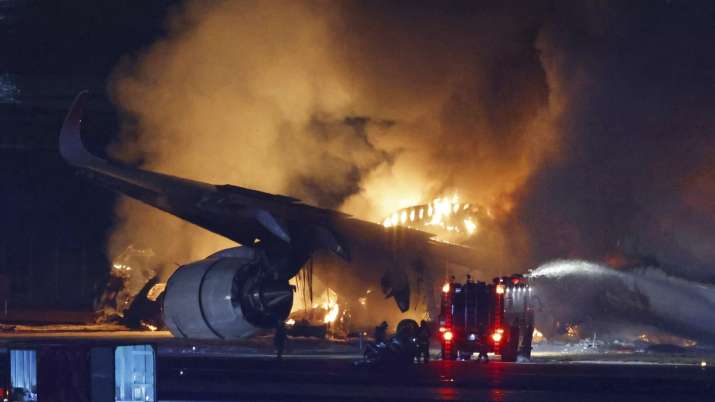
[ad_1]

One day after over 150 earthquakes struck Japan, the country witnessed another tragedy when a Japan Airlines (JAL) passenger plane and a coast guard aircraft collided on the runway of Tokyo’s Haneda Airport on Tuesday, causing them to burst into flames and killing five out of the six crew members aboard the coast guard plane, according to officials.
However, all 379 passengers and crew members aboard the Airbus A350 miraculously survived the accident before the plane was engulfed in flames, thanks to successful evacuations by the fire crews and JAL officials. The fire was extinguished after at least six hours. Police are expected to investigate the accident on suspicion of professional negligence.
Shigenori Hiraoka, head of the Transport Ministry Civil Aviation Bureau, praised JAL for “taking appropriate procedures” to safely evacuate all passengers and crew members. A passenger told NHK that cabin attendants were calm and told everyone to leave their baggage behind, then all lights went off and the temperature inside the cabin started rising.
How did the passengers escape?
Amid panic following the accident, all passengers and crew members slid down the escape chutes within 20 minutes and survived. Some passengers told media interviews that they felt relieved only after reaching a grassy area beyond the tarmac. “The smoke in the cabin stung like hell. It was a hell. We have no idea where we are going so we just run out into the field. It was chaos,” said Swedish passenger Anton Deibe.
According to CNN, the successful evacuation was done thanks to a combination of modern safety standards and JAL’s own safety culture. “But knowing what I know about that airline, and how much effort they put into safety and into crew training, the fact that they did do such a good job shouldn’t be such a surprise,” said Graham Braithwaite, a professor at the UK’s Cranfield University.
Paul Hayes, director of air safety at UK-based aviation consultancy Ascend by Cirium, noted that no one leaving the plane appeared to be carrying hand luggage – safety agencies have warned for years that pausing to collect carry-on bags during an evacuation risks lives.

Safety consultant John Cox also praised the cabin crew, saying that they “did a remarkably good job” getting the passengers out of the plane. “It shows good training…And if you look at the video, people are not trying to get stuff out of the overheads. They are concentrating on getting out of the airplane,” he said.
Seconds after the accident, escape chutes were inflated and those on board were quickly ushered off, even as the cabin filled with smoke. Aviation experts and pilots were left impressed by the relatively fast response and successful evacuation of the passengers in the panic-filled moment of crisis.
The aircraft’s in-flight announcement system did not work during the evacuation, so crew members used megaphones to give instructions, Japan Airlines said in a statement. “I heard an explosion about 10 minutes after everyone and I got off the plane,” said 28-year-old passenger Tsubasa Sawada. “I can only say it was a miracle, we could have died if we were late.”
Lessons from the past
Tuesday’s accident was the first severe damage to an Airbus A350 that entered into commercial service in 2015. The fire is likely to be seen as a key test case for airplane fuselages made from carbon-composite fibers, such as the A350 and the Boeing 787, instead of conventional aluminum skins.
However, JAL’s disaster response comes from a tragic incident on August 12, 1985, when JAL flight 123 from Tokyo to Osaka crashed, resulting in the deaths of 520 people onboard. The accident was blamed to a faulty repair of the tail by Boeing technicians, making it the deadliest single-plane accident in the aviation industry.
Nearly 40 years after, the crash has had a profound impact on the country’s safety guidelines. “They have a very strict culture around standard operating procedures and doing everything properly. That’s one of the reasons in this case I think the crew seems to have performed so well,” said Braithwaite.
JAL is regularly named among the world’s safest airlines in a high-profile annual listing website called Airlineratings.com. “Japan Airlines has enjoyed an excellent safety (record) since 1985. However that accident was not the airline’s fault and was due to defective repair performed by Boeing,” said Editor-in-Chief Geoffrey Thomas.
A pilot for a major European airline, who chose to remain anonymous, told CNN that modern aviation’s safety records are “written in the blood of others who haven’t been so fortunate”. “I’m exceptionally impressed with the pilots, crew, and passengers for what seems to have been a textbook evacuation in the most extreme of conditions,” they added.
What next?
As the country is embroiled in the outbreak of a devastating earthquake that killed over 50 people, transport safety officials have started analysing communication between aviation control officials and the two aircraft and planned to interview JAL officials to determine what led to the collision.
Fourteen people on the passenger plane were injured, according to Japan Airlines, but none of the injuries appeared to be life-threatening. Airbus said in a statement that it was sending specialists to help Japanese and French officials investigate the accident, and that the plane was delivered to Japan Airlines in late 2021.

A ministry official said that the JAL plane was attempting to land normally when it collided with the Coast Guard’s Bombardier-built Dash-8 maritime patrol plane on the runway. Coast Guard spokesperson Yoshinori Yanagishima said its Bombardier Dash-8 plane, which is based at Haneda, had been due to head to Niigata to deliver relief goods to residents affected by a deadly earthquake in the region on Monday.
Haneda, one of the two main airports serving the Japanese capital Tokyo, was closed for several hours following the accident, but the transport ministry official said three runways had since resumed operations. Prime Minister Fumio Kishida said authorities were working to ensure the accident did not affect deliveries of earthquake relief supplies, and expressed sorrow over the deaths of the Coast Guard crew.
(with inputs from agencies)
ALSO READ | Watch: The moment when Japan Airlines aircraft caught fire at Tokyo’s Haneda Airport
[ad_2]
Source link